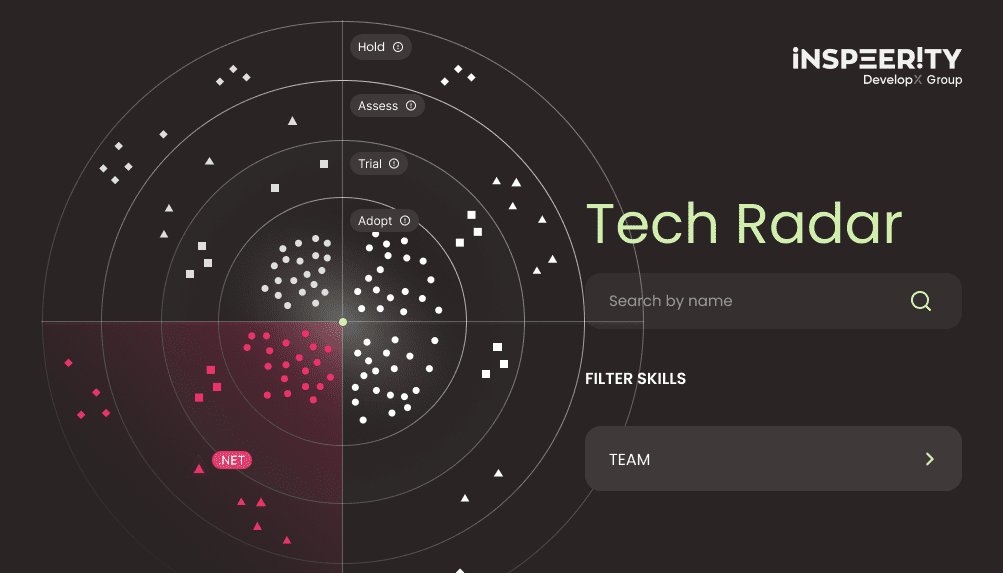If I could make a list of the most frequently asked questions by a client, “team composition” would feature in the top three for sure, if not number 1. Why is that? Because making a strong team is one of the most important parts that brings value to the business. That’s why we put so much effort into this process in “Inspeerity”. But don’t stress, we will take care of it for you. We’ve built our working model here through years of hard work, adding something new, eliminating unnecessary steps, and getting feedback from our partners. Practice makes perfect, yet “Perfect” is always different.
Let me share the 10 most popular questions I get asked about team composition by clients
To begin, we work on Agile principles. If you’ve never encountered Agile before or want to know more, we have an article explaining all here. But with that said, let’s carry on with our list
- How long does it take from an agreement being made to the first team members being available to work?
- Are there any contractual limits to scaling up to more team members ?
- Are there any contractual limits to scaling down to fewer team members ?
- How quickly can new team members / teams be added?
- Do you maintain a bench of immediately available team members?
- Are you able to supply team members to augment our existing teams (alongside full-time staff)?
- Can you supply team members to augment our existing teams (alongside our other partner’s staff)?
- Are you able to supply a dedicated team and if so, what is the typical profile of these teams?
- Is your team experienced in agile development practices, such as Scrum?
- What do you do to quickly and effectively integrate your team members into a client’s organization?
1. How long does it take from an agreement being made to the first team members being available to work?
We start looking for candidates even before we sign the agreement. Usually, it takes 2 – 4 weeks to find a candidate in our main technologies and 4 – 6 if we are looking for a niche skill.
2. Are there any contractual limits to scaling up to more team members?
No, we do not have such limitations. We try not to scale up the team by more than 50% per month for teams consisting of more than 10 members if one team lead is involved. This speeds up onboarding and delivering value in the project. For larger projects, we offer separate teams and add additional leaders. At the same time every project is different, so we don’t write these rules in stone.
3. Are there any contractual limits to scaling down to fewer team members?
We do not have such limits. Usually, we have one month’s notice, so if you need to scale down your team you can do it.
4. How quickly can new team members / teams be added?
Usually, it takes between 2 and 6 weeks. It depends on the technology and the project load. We keep a few people on the bench waiting to start new assignments, but sometimes we need to look for new hires to fill specific niche technologies. All the time we have a significant pipeline of new candidates in the most popular technologies.
5. Do you maintain a bench of immediately available team members?
We try to maintain a bench of 3 – 5 developers to fill any additional needs when they arise. But due to recent market conditions it has made the situation difficult. We always have open positions for good engineers, therefore our pipeline of new candidates is big, and we can act very quickly to find skilled people.
6. Are you able to supply team members to augment our existing teams (alongside full-time staff)?
Yes, we provide team augmentation services, this is an important part of our main business model – delivering resources who can integrate with your team. This model allows you to run the team, have a leader on your side, and devs who commit 100% of their time to your project.
7. Can you supply team members to augment our existing teams (alongside our other partner’s staff)?
Yes, we are. We can work with client’s teams as well as teams from other partners. We always try to build one team with common goals, no matter where the other team members are from.
8. Are you able to supply a dedicated team and if so, what is the typical composition of this team?
Yes, we deliver dedicated teams built on the project’s needs. As a rule, the dedicated team consists of a Team Leader, developers and QA engineers. However, we can add Scrum Masters/Business analysts depending on the customers’ request. The size of the team also depends on the size of the project.
9. Is your team experienced in agile development practices, such as Scrum?
Yes, most of the projects we deliver are in Agile (SCRUM/Kanban). If you want to read more about the difference, you can find more information about SCRUM and Kanban here. We have 13 Certified Scrum Masters (SCM I) in the company.
10. What do you do to quickly and effectively integrate your team members into a client’s organization?
I can answer the question with a practical example. A good demonstration of our approach to collaboration and engagement would be one of our recent projects.
First step
After a round of meetings with our COO/Delivery Director and our Technical Lead, who was most suited to the project. We proposed how we approach the situation most effectively, and our proposition met with the client’s approval.
Second step
From Inspeerity’s side we assigned Tech Leads and a Senior developer and started working intensively with the Product Owner and a Scrum Master on the client’s side to get to know the project. We defined a roadmap of the most urgent functionalities, the schedule of the delivery and the team needed. After about two weeks we knew enough to start the assignment.
Third step
We decided to create several small and self-sufficient teams that could focus on different areas of the project and would be easier to manage instead of one large group. Within one month we created the first team of 6 people, after another 2 months the second one (both teams were a mix of people from both Inspeerity and the client’s side). After a while due to the needs of the project a third development team was created. A few months into the project, after proving our skills, the client decided that we should be given full control of managing these teams leaving only the Product Owner and Scrum Master roles on their side.
How it worked
The project mostly involved working remotely, having daily video meetings to discuss the project. Key developers from client’s side, the Scrum Master and Product Owner visited our offices every couple of weeks to work together for a few days. The same goes from our side: every couple of weeks our developers/leaders travelled to the client’s offices to talk with the business owners of different divisions, and to work with developers from one office.
From the management point of view, we kept weekly status meetings between the Delivery Director and KAM on our side and the CEO and stakeholders from the client’s side. We discussed the project’s progress, possible improvements and actions that we would have to take to improve overall cooperation.
Being transparent and open enabled both sides to introduce corrective actions – The result; each party was really happy from our partnership and no person we provided was questioned on their performance (we didn’t have to remove/replace any from our people).
The cooperation has been going on for almost two years now. We work with the client as partners, on the Inspeerity side the team currently consists of 14 people. CEO of the client’s company sees it as an endless cooperation, for them, we are part of his Team.
Looking for more information about some of our projects, then we have the information here.
Alternatively, read FAQ part I if you haven’t done it yet.
And that’s the Top 10 questions asked about our working model. If anything wasn’t covered here or if you like to learn more feel free to get in touch for a chat.




